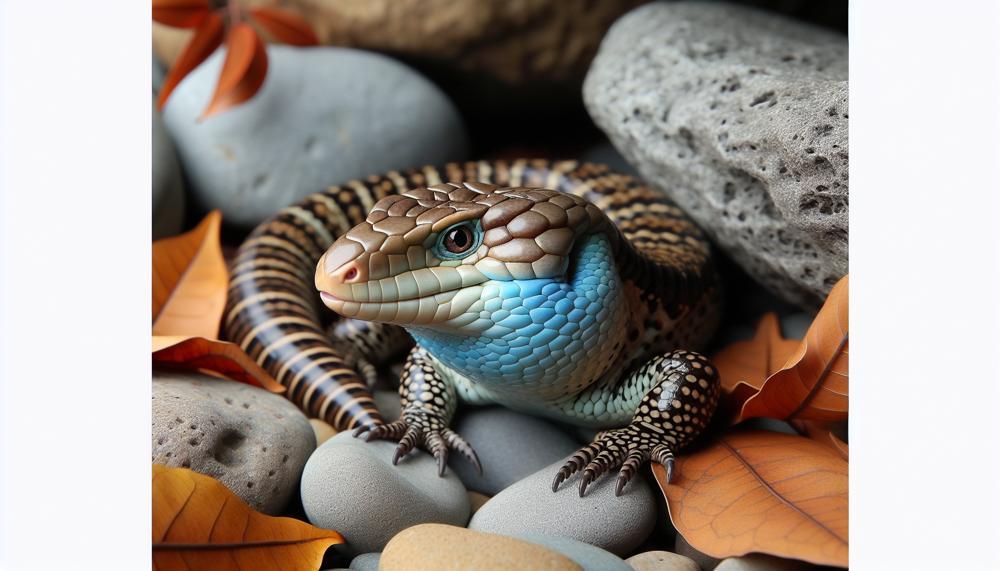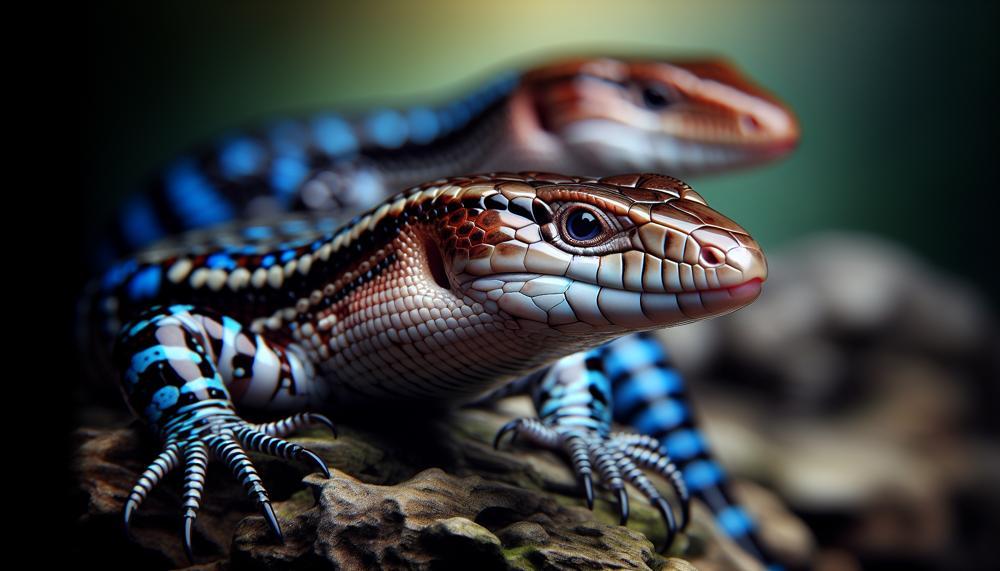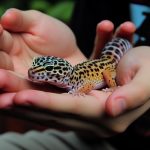Are you looking for a new pet that will bring joy and companionship? Do you want a pet that will stand out from the usual furry or feathered friends? Look no further than the Blue Tongued Skink.
These charming reptiles are known for their striking blue tongues and gentle personalities. This makes them a popular choice among reptile enthusiasts. But what makes them so friendly and unique?
Let’s delve deeper into the world of Blue Tongued Skinks:
- Social butterflies: Unlike other solitary reptiles, Blue Tongued Skinks thrive on social interaction. They love being handled and can even recognize their owners.
- Low maintenance: With minimal space requirements and an easy diet consisting of veggies and insects, these skinks make great pets for beginners or busy individuals.
- Docile darlings: Known as one of the most docile lizards, Blue Tongued Skinks rarely bite or show aggression towards humans.
So, if you’re ready to add some charm and warmth to your life, consider welcoming a Blue Tongued Skink into your home. In this blog post, we’ll take a closer look at their friendly nature and why they make such lovable companions.

Get ready to fall in love with these fascinating creatures.
Contents
- 1 What Is a Blue Tongue Skinks Usual Behaviour?
- 2 Are Blue Tongued Skinks Friendly?
- 3 Do Blue Tongue Skinks Behave Nicely Towards Children?
- 4 Does a Blue Tongue Skinks Behaviour Change When Hungry?
- 5 What Are The Signs That a Blue Tongue Skinks Behaviour Has Changed?
- 6 What Are The Factors For Blue Tongue Skinks Behaviour Changes?
- 7 Conclusion
What Is a Blue Tongue Skinks Usual Behaviour?
Blue tongue skinks are commonly found in solitary in their natural habitat. They are most active during the day. They spend a lot of time basking in the sun to regulate their body temperature.
These opportunistic omnivores have a varied diet that depends on what food is available. Blue tongue skinks are not known to be social creatures. However, they may temporarily share burrows or bask together in the sun.
When threatened, they can display a bright blue tongue. They can become accustomed to human interaction when kept in captivity.
Blue tongue skinks have developed various defense mechanisms to protect themselves from predators like birds of prey, snakes, and feral cats. Their tough skin and camouflage help them blend into their surroundings.
Proper handling and care are essential for maintaining their friendly temperament. Regular check-ups with a veterinarian are necessary to prevent any potential health concerns.
Overall, blue tongue skinks may not be the most social animals. However, they make fascinating pets for those dedicated to providing them with the right environment and care.
Are Blue Tongued Skinks Friendly?
Blue Tongued Skinks possess various characteristics that have made them a popular choice for friendly pets. Some of these include:
- Docile and Serene Nature: Blue Tongued Skinks are well-known for their calm and easy-going nature, making them ideal pets for children and first-time reptile owners. They are not aggressive and are comfortable with being handled, making interactions and care effortless.
- Socialization: Despite being solitary creatures, blue tongue skinks can still be socialized with their owners. Regular handling can help them recognize their owners and become more at ease with human interaction.
- Long Lifespan: In captivity, Blue Tongued Skinks can live up to 15-20 years, making them a long-term commitment for pet owners. This extended lifespan allows for a strong bond to form between the skink and its owner, contributing to its friendly reputation.
- Low Maintenance: These reptiles have minimal requirements when it comes to their habitat and diet, making them relatively low maintenance pets. This also translates to cost-effectiveness as they do not require specialized food or equipment.
- Easy to Breed: Breeding Blue Tongued Skinks is relatively simple during the spring season, contributing to their availability as pets. This also means there is a continuous supply of captive-bred skinks, reducing the need for wild-caught ones.
- Shedding: Blue Tongued Skinks undergo shedding several times a year, allowing them to grow and replace damaged skin. However, this process also means regular handling is necessary to check for any issues.
- Unique Appearance: With their distinctive blue tongues and tough skin, Blue Tongued Skinks are intriguing pets to observe and interact with. Their appearance can also spark conversations for those who own them.
To ensure a healthy and friendly relationship with your Blue Tongued Skink, here are some tips:
- Spend quality time with your skink daily to bond and socialize.
- Provide a spacious and comfortable habitat for your skink to thrive in.
- Offer a varied and nutritious diet to ensure your skink’s well-being.
- Regularly check for signs of shedding or any health issues that may arise.
- Respect your skink’s boundaries and preferences to maintain a harmonious relationship.
Remember, building a strong bond with your Blue Tongued Skink takes time, patience, and effort.
Do Blue Tongue Skinks Behave Nicely Towards Children?
Blue Tongue Skinks are known for their friendly behavior towards children. This makes them an excellent choice for families with young kids. Their composed temperament, lack of hostility, and kind disposition make them a safe companion for children to interact with.
It is crucial for parents to closely monitor their children and educate them on the appropriate ways to handle these reptiles. This ensures the safety of both the child and the skink.
It’s worth mentioning that Blue Tongue Skinks are gentle towards children. To add more detail, They also have a fascinating, curious nature that can captivate young minds. These reptiles have unique personalities. They can form strong bonds with their owners. This makes them a great pet for kids to learn about responsibility and animal care.
It is also important to note that while Blue Tongue Skinks are generally well-behaved. They still require proper handling and respect from children. This means avoiding rough play or sudden movements that could startle or harm the skink.
Additionally, young children should always be supervised when interacting with these pets. This helps avoid accidental injuries.
Does a Blue Tongue Skinks Behaviour Change When Hungry?
Hunger can trigger changes in a Blue Tongue Skink’s behavior, causing it to exhibit certain behaviors that may differ from its usual demeanor. These changes can be observed in the following ways:
- Heightened activity: When a Blue Tongue Skink is hungry, it will often become more active and explore its surroundings with increased vigor. This is because the skink is on the lookout for food and will frequently move around its tank.
- Aggression towards food: In the case of extreme hunger, a Blue Tongue Skink may display aggressive behavior towards its food. This can take the form of biting or lunging at prey items, which is a natural hunting instinct for reptiles.
- Begging behavior: Some Blue Tongue Skinks may resort to begging when they are hungry, attempting to get their owner’s attention by climbing on them or nudging them for food.
- Vocalizations: While not all Blue Tongue Skinks vocalize, some may make noises when they are hungry, such as chirping or grunting sounds. This is their way of communicating their need for sustenance.
What Are The Signs That a Blue Tongue Skinks Behaviour Has Changed?
A blue tongue skink’s behavior can change in various ways, and there are several signs to look out for. These include:
- Alterations in Activity Level: Blue tongue skinks are naturally active and curious animals. If you observe your skink becoming more lethargic, hiding more often, or avoiding interactions with you, it could be a sign of behavioral changes.
- Changes in Appetite: A sudden loss of appetite or decrease in food intake may indicate a behavior change. This can be caused by factors such as stress, illness, or changes in their environment.
- Abnormal Stool: Pay attention to your skink’s stool as it can provide valuable information about their health. Any changes in color, consistency, or frequency could be a sign of a behavior change.
- Weight Loss: A decrease in appetite and changes in stool can lead to weight loss in blue tongue skinks. It is important to regularly weigh your skink to monitor for any significant changes.
- Difficulty Breathing: Respiratory issues can be a sign of illness or stress in blue tongue skinks. If your skink is wheezing, gasping for air, or has discharge from its nose or mouth, it is crucial to take them to the vet immediately.
- Changes in Appearance: Regularly observe your skink’s physical appearance for any changes. Swollen or curved limbs, abnormal skin color, and visible parasites can all be indicators of behavior changes.
- Unusual Behavior: Blue tongue skinks are typically docile and friendly creatures, so any sudden aggression or fear towards their owner or food may indicate a change in behavior.
If you notice any of these signs in your blue tongue skink, closely monitor them. Consult a veterinarian if necessary.
What Are The Factors For Blue Tongue Skinks Behaviour Changes?
Environmental factors, like temperature and lighting, heavily influence the behavior of blue tongue skinks. These factors have a direct impact on their overall health, stress levels, and social behavior. Inadequate temperature regulation and lighting can result in serious health problems and behavioral changes for these reptiles.
Temperature is a critical factor for blue tongue skinks as they rely on their environment to regulate their body temperature. In captivity, it is crucial to provide them with a suitable temperature gradient. This includes a designated basking spot and cooler areas.
This enables the skinks to effectively regulate their body temperature. If the temperature is too hot or too cold, it can cause significant stress on the skink. This can lead to digestive issues, dehydration, and changes in behavior.
Lighting also plays a significant role in the behavior of blue tongue skinks. In their natural habitat, these reptiles are exposed to sunlight for several hours each day, which provides them with essential UVB rays.
These rays help them produce vitamin D3, which is necessary for proper calcium absorption. For this reason, it is crucial to provide UVB lighting in captivity. This mimics the natural sunlight that blue tongue skinks require.
Without adequate UVB lighting, these reptiles can develop metabolic bone disease. It causes pain and discomfort and changes their behavior.
Conclusion
In conclusion, Blue Tongued Skinks are not only intriguing and adorable pets. They are also known for their friendly nature.
Reptile lovers are drawn to their social nature, low maintenance, and gentle personality. This makes them a top choice. However, it’s crucial to provide them with the proper care and attention. This will help maintain their friendly nature.
You can form a strong bond with these captivating creatures. Gain insight into their natural behaviors and fulfill their needs.






